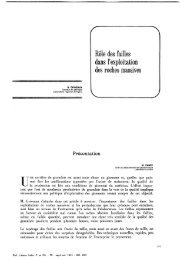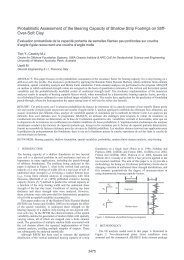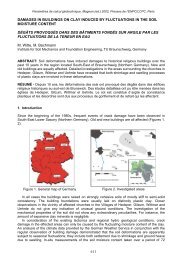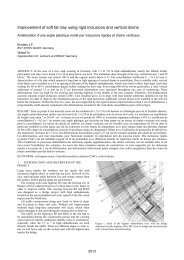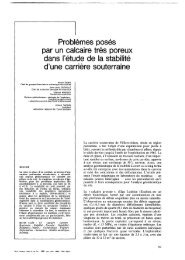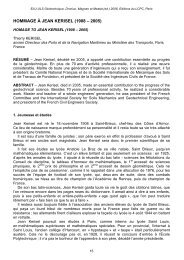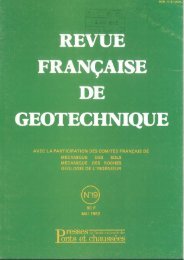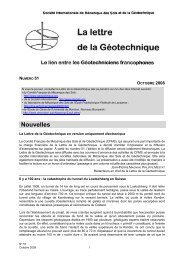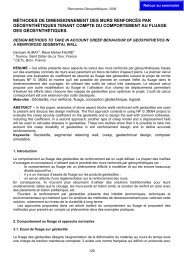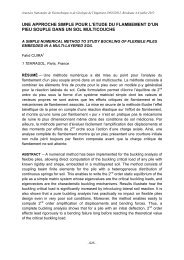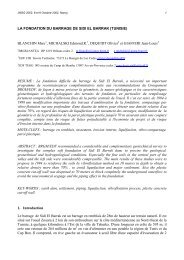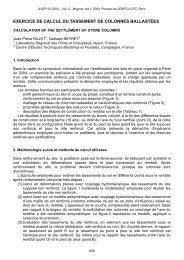THE VIBRATORY PILE INSTALLATION TECHNIQUE - Viking
THE VIBRATORY PILE INSTALLATION TECHNIQUE - Viking
THE VIBRATORY PILE INSTALLATION TECHNIQUE - Viking
You also want an ePaper? Increase the reach of your titles
YUMPU automatically turns print PDFs into web optimized ePapers that Google loves.
intuitively the direction and variation of interlock friction force R c should be correlated with thepattern of the shaft resistance (R s –u) curve.4.3. Theoretical prediction of SRVDFrom an engineering point, being able to estimate the magnitude of SRVD (read R t and R s )versus depth z is the key for a reasonable prediction of the penetration speed v p . Vibrodrivabilityin a broad sense is defined by the shape of the (v p -z) curve as a result of the dynamicequilibrium of the vibro/pile/soil system, schematically illustrated by figure 5.The difficulty in predicting the magnitude of encountered SRVD boils down to the lack ofappropriate soil investigation methods that duplicates the conditions in the vicinity of a vibrodrivenpile. Its still standard investigation methods that are devised to characterize themagnitude of SRVD, such as: i.) probing tests (CPT and SPT), ii.) sampling tests and iii.)laboratory tests (tri-axial, resonant column, and direct shear tests). All which have beendeveloped to produce input for static design issues. And it’s obvious that these are not suitableto quantify the magnitude of SRVD. However, promising attempts do exist. One of the morerecent attempts can be found in (Bonita 2000).In countries such as; Belgium, the Netherlands, Germany, France and Sweden to mention afew, were majority of the steel sheet piles are installed with vibro-drivers/extractors. Severalprediction methods have emerged regarding choice of minimum required vibro-driving force todrive a specific sheet pile to designated design depth in a specific soil profile. The more notableattempts, all mentioned in (<strong>Viking</strong> 2002), are based on results of conducted CPT-tests, were thequasi-static cone q c and sleeve friction f s have been empirically reduced to levels resemblingthe dynamic soil resistance in the vicinity of a vibro-driven pile. The author applies the followingmethods, depending whether if it’s an on- or offshore-related job.4.3.1. Onshore jobsThe SRVD are estimated according to the Vibdrive model that was initially developed by(Holeyman 1993), and have undergone refinements by [(De Cock 1998; Vanden Berghe 1997).The SRVD estimate is rather simple; it’s based on the driving unit resistance at toe q d and alongshaft d that are correlated with pile geometry. Estimated R t,max and ±R s,max are then modeledas constants both with respect to time and displacement, see figure 8. However simple or not,the model does incorporate the two main soil related factors, i.e. i.) the cyclic motion of grainsdue to vibratory accelerations, and ii.) induced pore-pressure build up. Furthermore, the modelis based on the assumption that the vibro-unit and pile behaves as a rigid body, and thereforeallowed to apply Newton’s second law of motion to the moving masses. The theoretical drivingforce amplitude is calculated according to figure 2b, using rated values of f d , M e , and anassigned value of ξ



